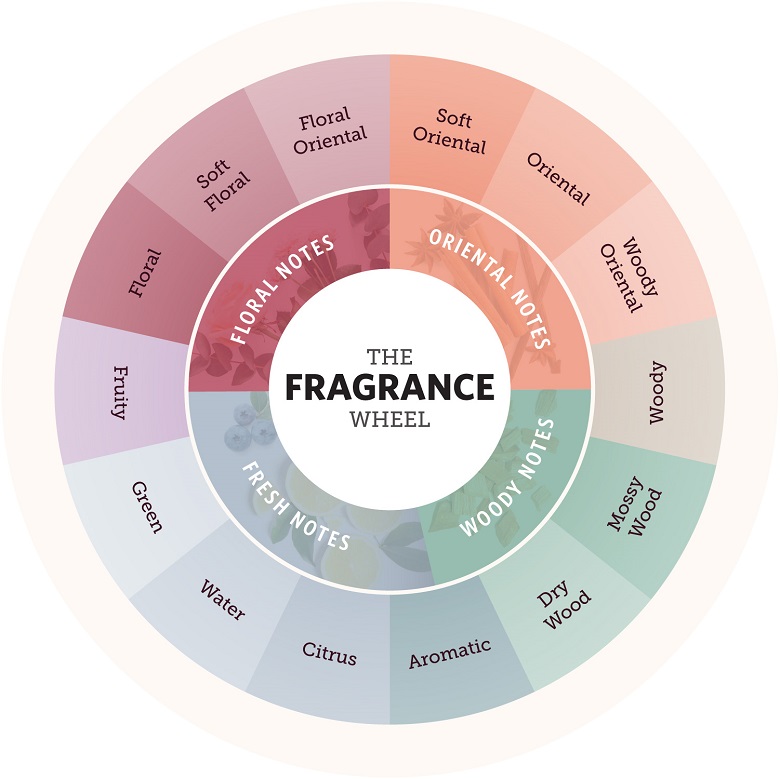Introduction:
Selecting the perfect fragrance is an art in itself, and understanding the fragrance wheel and scent families can be your guiding compass in this aromatic journey. Perfumes are a blend of diverse scent notes, each contributing to the overall bouquet. In this guide, we will demystify the fragrance wheel, explore the main scent families, delve into subfamilies, and even discuss how to combine scents. By the end, you’ll be equipped to confidently explore the world of perfumes and colognes.

What Is the Fragrance Wheel?
The fragrance wheel is your map to the enchanting world of scents. It’s a circular diagram that categorizes fragrances into distinct scent families and subfamilies. These classifications are based on the similarities and differences between scents, helping you understand their relationships. Fragrances that share borders on the wheel have common olfactory characteristics, while those farther apart exhibit less similarity.
The fragrance wheel was designed by fragrance expert Michael Edwards to assist retailers in suggesting perfumes efficiently. Each family features a dominant scent, while subfamilies represent variations of these fragrances.
Types of Scent Families
Scent families are the foundation of fragrance classification, falling into four main categories: Floral, Oriental, Woody, and Fresh. Each family has its unique characteristics, making them suitable for various individuals and occasions. Discovering your preferred scent family is a crucial first step in your fragrance journey.
Floral: The floral scent family is abundant and evokes the aroma of fresh-cut flowers. It is a common choice for women’s fragrances, capturing the essence of blooming gardens. Subfamilies within floral include Fruity (sweet and tropical), Floral (fresh-cut flowers), Soft Floral (powdery and sweet), and Floral Oriental (florals with subtle spice).
Oriental: Oriental fragrances are exotic and heady, often featuring herbs, spices, and warm notes. They are characterized by opulence and seduction. Subfamilies include Soft Oriental (soft florals with incense and spices), Oriental (sweet and warm notes like cinnamon and musk), and Woody Oriental (earthy notes with spices).
Woods: Woodsy perfumes are warm and opulent, blending earthy elements like sandalwood and patchouli with drier notes such as cedar. They may incorporate fresh scents like citrus or florals to balance the warmth. Subfamilies include Woods (aromatic scents like cedarwood and vetiver), Mossy Woods (smooth and earthy scents like oakmoss and amber), and Dry Woods (smoky with leather aromas).
Fresh: Fresh fragrances are crisp, bright, and clean, often featuring citrus, herbal, or oceanic notes. While frequently used in men’s fragrances, they can be paired with spicy elements for a more robust scent. Subfamilies include Aromatic (clean herbs mixed with lavender or woody scents), Citrus (zesty and tangy notes like bergamot), Green (smells of freshly mowed lawns), and Water (aquatic scents like sea spray or rain).
Fragrance Pairing: How to Combine Scents
Pairing fragrances is akin to creating a harmonious symphony of scents. Scent families that neighbor each other on the fragrance wheel naturally complement one another. Additionally, you can select complementary pairs by choosing a subfamily and identifying the note opposite it on the wheel. These combinations are often harmonious.
For instance, soft oriental complements citrus, while oriental pairs well with water. You can also create a well-rounded fragrance by selecting three subfamilies that form a triangle on the wheel. This ensures a balanced and appealing blend.
Find the Perfect Perfume Scent Type for You
Armed with an understanding of the fragrance wheel and scent families, you are now ready to embark on your fragrance journey. Whether you gravitate towards the opulence of oriental scents, the freshness of florals, the warmth of woods, or the crispness of fresh notes, you can confidently explore perfumes and colognes that resonate with your style and preferences. Remember to test fragrances on your skin to ensure a harmonious blend with your body chemistry, and let your fragrance become an extension of your personality and style.



 No products in the cart.
No products in the cart.